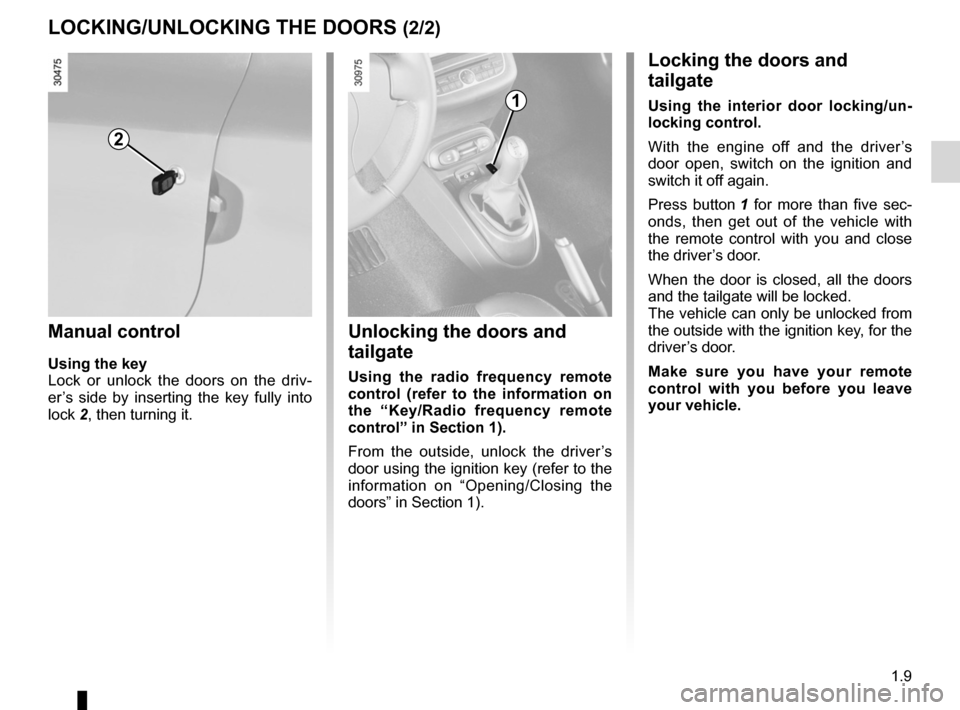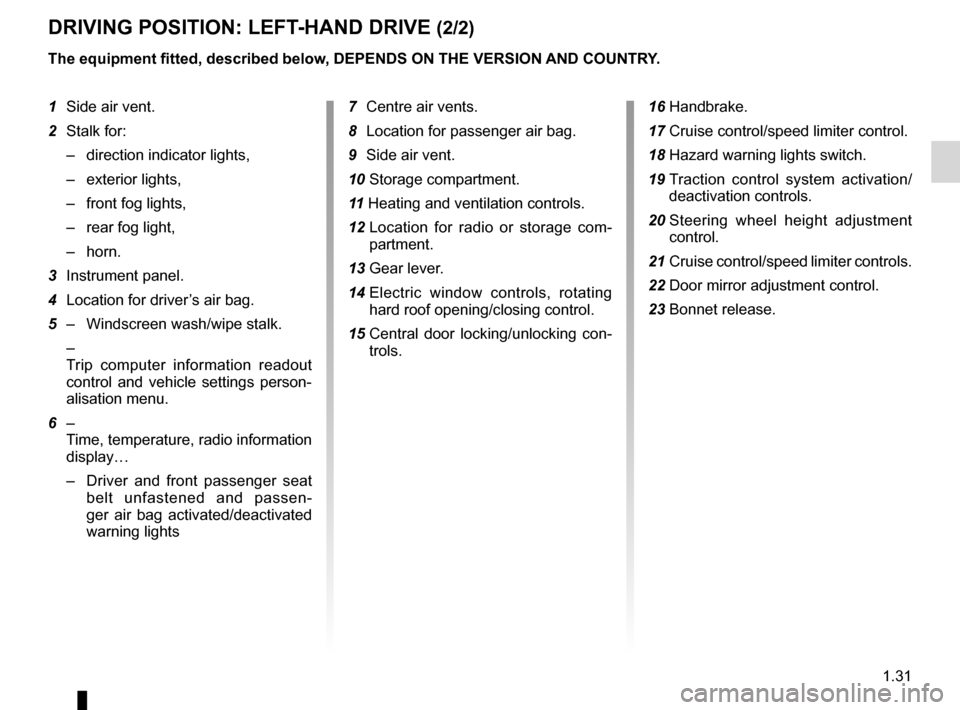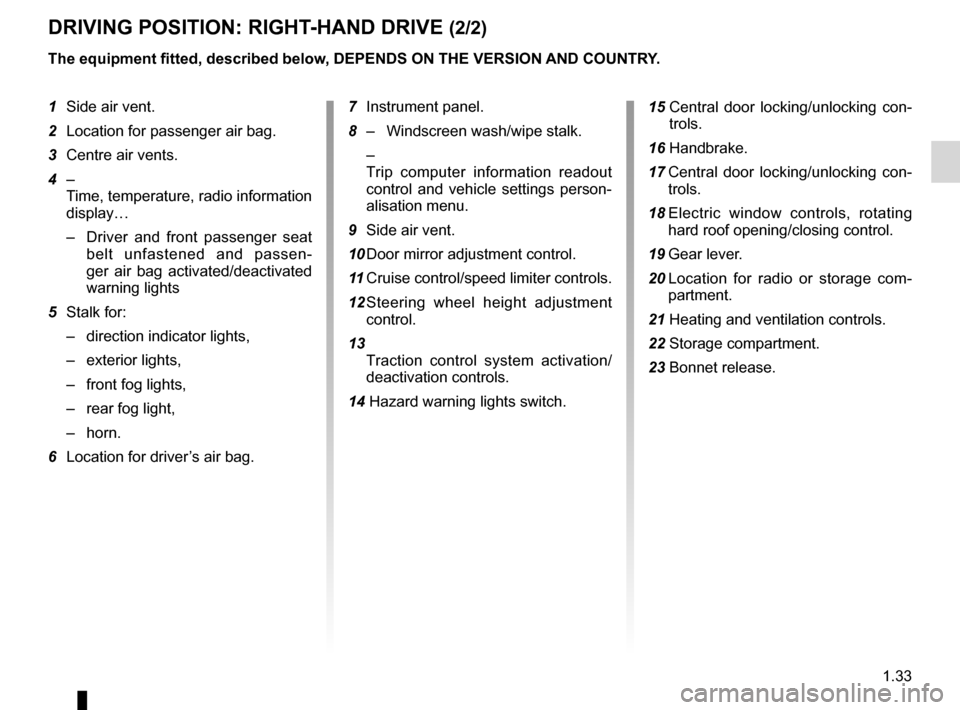2012 RENAULT WIND door lock
[x] Cancel search: door lockPage 15 of 185

JauneNoirNoir texte
1.9
ENG_UD11151_1
Verrouillage / Déverrouillage des portes (E33 - X33 - Renault)
ENG_NU_865-6_E33_Renault_1
LOCKING/UNLOCKING THE DOORS (2/2)
Unlocking the doors and
tailgate
Using the radio frequency remote
control (refer to the information on
the “Key/Radio frequency remote
control” in Section 1).
From the outside, unlock the driver’s
door using the ignition key (refer to the
information on “Opening/Closing the
doors” in Section 1).
Manual control
Using the key
Lock or unlock the doors on the driv -
er’s side by inserting the key fully into
lock 2, then turning it.
2
Locking the doors and
tailgate
Using the interior door locking/un -
locking control.
With the engine off and the driver ’s
door open, switch on the ignition and
switch it off again.
Press button 1 for more than five sec -
onds, then get out of the vehicle with
the remote control with you and close
the driver’s door.
When the door is closed, all the doors
and the tailgate will be locked.
The vehicle can only be unlocked from
the outside with the ignition key, for the
driver’s door.
Make sure you have your remote
control with you before you leave
your vehicle.1
Page 16 of 185

RENAULT ANTI-INTRUDER DEVICE (RAID) (up to the end of the DU)
central door locking .............................. (up to the end of the DU)
doors ..................................................... (up to the end of the DU)
locking the doors .................................. (up to the end of the DU)
doors/tailgate ........................................ (up to the end of the DU)
1.10
ENG_UD11152_1
Condamnation automatique des ouvrants en roulage (E33 - X33 - Renault)
ENG_NU_865-6_E33_Renault_1
Automatic locking when driving
AUTOMATIC LOCKING WHEN DRIVING
You must first decide if you want to
activate this function.
To activate
With the ignition on, press central door
locking button 1 for about five seconds,
until a double beep is heard.
To deactivate
With the ignition on, press central door
locking button 1 for about five seconds,
until a double beep is heard.
Driver’s responsibility
If you decide to keep the
doors locked when you are
driving, remember that it
may be more difficult for those as -
sisting you to gain access to the
passenger compartment in the
event of an emergency.
The door can be unlocked:
– by opening a door when stationary.
Note: if a door is opened, it will auto-
matically be locked again when the
vehicle reaches a speed of approxi -
mately 4 mph (7 km/h);
– by pressing door unlocking button 1.
Operating faults
If you find an operating fault (no au -
tomatic locking, the indicator light for
button 1 does not light up when trying
to lock the doors and luggage com -
partment lid, etc.), firstly check that the
doors and luggage compartment lid are
properly closed. If they are properly
closed, contact an approved dealer.
Operating principle
When the vehicle is started, the system
automatically locks the doors as
soon as a speed of 4 mph (7 km/h) is
reached.
The button’s indicator light 1 comes on.
1
Page 26 of 185

child safety............................................ (up to the end of the DU)
child restraint/seat ................................ (up to the end of the DU)
child restraint/seat ................................ (up to the end of the DU)
child restraint/seat ................................ (up to the end of the DU)
child seats ............................................. (up to the end of the DU)
transporting children ............................. (up to the end of the DU)
children ................................................. (up to the end of the DU)
1.20
ENG_UD20549_2
Sécurité enfants : généralités (E33 - X33 - Renault)
ENG_NU_865-6_E33_Renault_1
Jaune NoirNoir texte
Child safety: General information
CHILD SAFETY : General information (1/2)
Carrying children
Children, and adults, must be correctly
seated and strapped in for all journeys.
The children being carried in your vehi-
cle are your responsibility.
A child is not a miniature adult. Children
are at risk of specific injuries as their
muscles and bones have not yet fin -
ished growing. The seat belt alone
would not provide suitable protection.
Use an approved child seat and ensure
you use it correctly.
A collision at 30 mph (50
km/h) is the same as fall -
ing a distance of 10 metres.
Transporting a child without
a restraint is the equivalent of allow-
ing him or her to play on a fourth -
floor balcony without railings.
Never travel with a child held in your
arms. In the event of an accident,
you will not be able to keep hold of
the child, even if you yourself are
wearing a seat belt.
If your vehicle has been involved
in a road accident, replace the
child seat and have the seat belts
checked.
D r i v e r ’s r e s p o n s i b i l i t y
when parking or stopping
the vehicle
Never leave an animal,
child or adult who is not self-suffi -
cient alone on your vehicle, even for
a short time.
They may pose a risk to themselves
or to others by starting the engine,
activating equipment such as the
electric windows or by locking the
doors.
Also, in hot and/or sunny weather,
please remember that the tempera-
ture inside the passenger compart-
ment increases very quickly.
RISK OF DEATH OR SERIOUS
INJURY.
To prevent the doors being
opened, use the “Child
safety” device (refer to the
information on “Opening
and closing the doors” in Section 1).
Page 37 of 185

JauneNoirNoir texte
1.31
ENG_UD11168_1
Poste de conduite direction à gauche (E33 - X33 - Renault)
ENG_NU_865-6_E33_Renault_1
DRIVING pOSITION: LEFT -HAND DRIVE (2/2)
1 Side air vent.
2 Stalk for:
– direction indicator lights,
– exterior lights,
– front fog lights,
– rear fog light,
– horn.
3 Instrument panel.
4 Location for driver’s air bag.
5 – Windscreen wash/wipe stalk.
–
Trip computer information readout
control and vehicle settings person-
alisation menu.
6 –
Time, temperature, radio information
display…
– Driver and front passenger seat
belt unfastened and passen -
ger air bag activated/deactivated
warning lights
The equipment fitted, described below, DEpENDS ON THE VERSION AND COUNTRY.
16 Handbrake.
17 Cruise control/speed limiter control.
18 Hazard warning lights switch.
19 Traction control system activation/
deactivation controls.
20 Steering wheel height adjustment
control.
21 Cruise control/speed limiter controls.
22 Door mirror adjustment control.
23 Bonnet release.
7
Centre air vents.
8 Location for passenger air bag.
9 Side air vent.
10 Storage compartment.
11 Heating and ventilation controls.
12 Location for radio or storage com -
partment.
13 Gear lever.
14 Electric window controls, rotating
hard roof opening/closing control.
15 Central door locking/unlocking con -
trols.
Page 39 of 185

JauneNoirNoir texte
1.33
ENG_UD11169_1
Poste de conduite direction à droite (E33 - X33 - Renault)
ENG_NU_865-6_E33_Renault_1
DRIVING pOSITION: RIGHT -HAND DRIVE (2/2)
The equipment fitted, described below, DEpENDS ON THE VERSION AND COUNTRY.
1 Side air vent.
2 Location for passenger air bag.
3 Centre air vents.
4 –
Time, temperature, radio information
display…
– Driver and front passenger seat
belt unfastened and passen -
ger air bag activated/deactivated
warning lights
5 Stalk for:
– direction indicator lights,
– exterior lights,
– front fog lights,
– rear fog light,
– horn.
6 Location for driver’s air bag. 7
Instrument panel.
8 – Windscreen wash/wipe stalk.
–
Trip computer information readout
control and vehicle settings person-
alisation menu.
9 Side air vent.
10 Door mirror adjustment control.
11 Cruise control/speed limiter controls.
12 Steering wheel height adjustment
control.
13 Traction control system activation/
deactivation controls.
14 Hazard warning lights switch. 15
Central door locking/unlocking con -
trols.
16 Handbrake.
17 Central door locking/unlocking con -
trols.
18 Electric window controls, rotating
hard roof opening/closing control.
19 Gear lever.
20 Location for radio or storage com -
partment.
21 Heating and ventilation controls.
22 Storage compartment.
23 Bonnet release.
Page 67 of 185

starting the engine ................................ (up to the end of the DU)
starting the engine ................................ (up to the end of the DU)
2.3
ENG_UD29995_3
Démarrage / Arrêt moteur avec carte RENAULT mains libres (E33 - X33 - Renault)
ENG_NU_865-6_E33_Renault_2
Starting, stopping the engine
St ARtING/StoPPING thE ENGINE
Starting the engine
Engine warm or cold:
– Turn the ignition key to “Start” posi-
tion D without accelerating;
– release the key as soon as the
engine starts.
Special note: if starting the engine
when the outdoor temperature is very
low (below - 10 ° C): hold down the
clutch pedal until the engine starts.
Stopping the engine
With the engine idling, turn the key
back to “Stop” position St.
Driver’s responsibility
Never leave your vehicle
with the key or remote con-
trol inside the vehicle and
never leave a child (or a pet) unsu-
pervised, even for a short while.
There is a risk that they could start
the engine or operate electrical
equipment (electric windows etc.)
and trap part of their body (neck,
arms, hands, etc.).
Risk of serious injury.
Never switch off the ignition
before the vehicle has stopped
completely . Once the engine has
stopped, the brake servo, pow -
erassisted steering, etc., and the
passive safety devices such as
air bags and pretensioners will no
longer operate.
The steering is locked when the key
is removed.
Page 104 of 185

lighting:interior ............................................. (up to the end of the DU)
courtesy light ........................................ (up to the end of the DU)
map reading lights ................................ (up to the end of the DU)
sun visor ............................................... (up to the end of the DU)
courtesy mirrors .................................... (up to the end of the DU)
3.20
ENG_UD11203_1
Eclairage intérieur (E33 - X33 - Renault)
ENG_NU_865-6_E33_Renault_3
Courtesy light
Tilt switch 1 to move it to the position
for:
– continuous lighting;
– intermittent lighting, which comes on
when a door is opened. It goes out
when the doors concerned are prop-
erly closed;
– immediate switching off.
Interior lighting
Sun visor
inteRioR ligHting/sun visoR
Unlocking the vehicle or opening
the doors switches on the timed
courtesy lights.
1
luggage compartment light
The light comes on when the luggage
compartment is opened.
sun visor
Lower sun visor 2.
2
automatic operation of interior
lighting (depending on the vehi -
cle)
– if the doors are unlocked using
the remote control, the interior
lights are switched on for approx -
imately 15 seconds;
– if the doors are locked using the
remote control, the lights are
switched off immediately;
– if the door is open (or not properly
closed), the lights are switched
on for a period of approximately
15 minutes;
– if all the doors are closed, the in-
terior lights start to dim when the
ignition is switched on.
Page 124 of 185

maintenance:interior trim ...................................... (up to the end of the DU)
interior trim maintenance ................................... (up to the end of the DU)
cleaning: inside the vehicle ............................ (up to the end of the DU)
4.14
ENG_UD22866_8
Entretien des garnitures intérieures (X35 - X45 - X65 - J77 - X81 - \
J81 - X85 - X91 - B91 - K91 - D91 - X83 - X61 - X77 ph2 - X95 - B95 - D9\
5 - E95 - K95 - J95 - R95 -
ENG_NU_865-6_E33_Renault_4
Jaune NoirNoir texte
Interior trim maintenance
glass instrument panel(e.g. instrument panel, clock, exterior
temperature display, radio display, etc.)
Use a soft cloth (or cotton wool).
If this does not clean it properly, use a
soft cloth (or cotton wool) slightly mois-
tened with soapy water and then wipe
clean with a soft damp cloth or cotton
wool.
Finally, carefully dry off with a soft dry
cloth.
Cleaning products containing alco -
hol must not be used under any cir-
cumstances.
Seat belts
These must be kept clean.
Use products selected by our Technical
Department (Approved outlets) or
warm, soapy water and a sponge and
wipe with a dry cloth.
Detergents or dyes must not be used
under any circumstances.
inteRioR tRiM MAintenAnCe (1/2)
textiles (seats, door trim, etc)
Vacuum-clean the textiles regularly.
liquid stain
Use soapy water.
Dab lightly (never rub) with a soft cloth,
rinse and remove the excess.
Solid or pasty stain
Carefully remove the excess solid or
pasty material immediately with a
spatula (working from the edges to the
centre to avoid spreading the stain).
Clean as for a liquid stain.
Special instructions for sweets or
chewing gum
Put an ice cube on the stain to solidify
it, then proceed as for a solid stain.
A well-maintained vehicle will last
longer. It is therefore recommended to
maintain the interior of the vehicle regu-
larly.
A stain should always be dealt with
swiftly.
Whatever type of stain is on the trim,
use
cold (or warm) soapy water with
natural soap.
Detergents (washing-up liquid, pow -
dered products, alcohol-based prod-
ucts) should not be used.
Use a soft cloth.
Rinse and soak up the excess.
For further recommendations for
maintaining the interior, and/or for
any unsatisfactory results, please
see an authorised dealer.